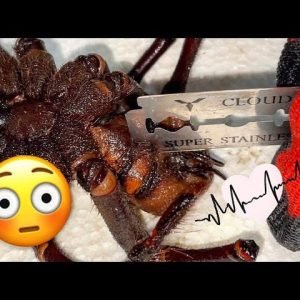Welcome to the extraordinary world of performing surgery on your very own giant tarantula, Death Nugget (just kidding, we’re actually preserving him – no harm done)! In this unique blog post, we will unravel the fascinating process of preserving Death Nugget, while giving you a glimpse into the world of tarantula surgery. So, get ready to embark on this thrilling adventure as you learn the ins and outs of caring for your eight-legged friend!
Performing Surgery on my Giant Tarantula, Death Nugget… (jk, we preserving him lol)
Introduction:
Have you ever wondered what goes into preserving a giant tarantula? In a recent video created by Exotics Lair, a popular YouTube channel focused on all things creepy crawly, the process of performing surgery on a giant Tarantula named Death Nugget is captured. In this article, we will dive into the intricate details of the surgery and preservation process, step by step. So, let’s get started!
- Soak the Theraphosa stirmi tarantula in alcohol to preserve it
To begin the preservation process, Exotics Lair starts by soaking the giant tarantula, Death Nugget, in alcohol. This helps to preserve the specimen and prevent any decay or decomposition. The alcohol acts as a natural preservative, allowing the tarantula to remain intact for years to come.
- Rinse the tarantula’s abdomen to remove guts and oil
Once the tarantula has soaked in alcohol, the next step is to give it a thorough rinse. This helps to remove any remaining guts and oil from the tarantula’s abdomen. It is important to ensure the specimen is clean before proceeding with the surgery.
- Stuff the tarantula’s body with toothpicks and seal with super glue
After the rinse, Exotics Lair begins the delicate process of stuffing the tarantula’s body with toothpicks. This helps to preserve its shape and structure. Once the body is filled, the next step is to carefully seal it with super glue, ensuring that it remains intact during the preservation process.
- Glue the broken back leg of the tarantula
During the surgery, it is discovered that the tarantula, Death Nugget, has a broken back leg. Exotics Lair takes this opportunity to not only preserve the tarantula but also repair its leg. With the help of super glue, the broken leg is carefully reattached, providing a natural and seamless look.
- Allow the tarantula to dry for two to three days
After the surgery is complete, it is essential to give the tarantula ample time to dry. This typically takes around two to three days, depending on the size of the specimen. Drying is crucial as it ensures that the preservation process is successful and that the tarantula retains its natural appearance.
The Result: The tarantula now looks more alive and is standing together with another tarantula
Now that Death Nugget, the giant tarantula, has gone through the preservation process, the result is astounding. The tarantula no longer appears lifeless but rather more alive, as if it could crawl at any moment. In the video, Death Nugget is seen standing side by side with another tarantula, showcasing its remarkable preservation.
Conclusion:
In this captivating video, Exotics Lair takes us through the intriguing process of preserving Death Nugget, a giant tarantula. From soaking the tarantula in alcohol to repairing a broken leg, every step is meticulously documented. The outcome is a preserved tarantula that appears surprisingly lifelike. It is truly fascinating to witness the extent to which preservation techniques can bring life back into a seemingly dormant creature.
FAQs:
-
How long does the preservation process take?
The preservation process typically takes around two to three days, allowing ample time for the tarantula to dry and the preservation techniques to take effect. -
Is the surgery painful for the tarantula?
As Exotics Lair ensures that the tarantula is deceased before beginning the preservation process, there is no pain inflicted on the specimen during the surgery. -
Can the preserved tarantula be displayed?
Yes, the preserved tarantula can be displayed. It is a unique and fascinating piece for enthusiasts or individuals interested in the world of preserved specimens. -
Are there any risks involved in the preservation process?
While the preservation process itself is relatively safe when performed carefully, it is essential to take precautions such as wearing gloves and ensuring proper ventilation when working with alcohol and super glue. -
Can the preservation process be done at home?
While it is possible to attempt the preservation process at home, it is strongly recommended to seek guidance from professionals or experts in the field to ensure the best possible result.
And that concludes our journey into the world of tarantula preservation. Remember, the process requires expertise and precision. If you’re ever curious about witnessing the fascinating preservation techniques, Exotics Lair’s video is definitely worth a watch!
